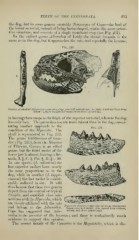Page 443 - My FlipBook
P. 443
TEETH OF THE VERTEBRATA. 453
the dog, but in some genera—notably Temnocyon of Cope—the heel of
the lower sectorial, instead of being basin-shaped, retains the more primi-
tive structure, and consists of a single trenchant cusp (see Fig. 231).
In the extinct genus AUurodon of Leidv the dental fornuda is the
same as in the dog, but it approaches the cats, and especially the hysenas,
Fig
Portiuu of ^kull of Olif/ubnuiis crits.siimlliix. Cope, one-half n-.itural size In, right maxiUary bone from
:
below ; 2, Mght maudibulur ramus from above (after Cope^
in having three cusps to the blade of the superior sectorial, whereas the dog
has only two. The premolars too are more robust than in the dog, consti-
tuting another approach to the
^la -y-^i
condition of the Uj/ceuida'. The
skull is represented in Fig. 232.
The genus Ichtifhcriam of Gau-
dry (Fig. 233), from the Miocene
of Pikermi, Greece, is an allied
genus, but the third molar of the
lower jaw is absent, leaving a for-
mula, I. f , C. I, Pm. f , M. = 40.
I
In one species (/. robuHium) the
last superior molars have nearly
the same proportions as in the
dog, while in anotlier (J. hippa-
rionum) the last molar is consid-
erably reduced in size. It will
thus be seen that these two genera
depart from the central or typical
Cankke, and establish close con-
nections with the Hycenidce, which
are closely affiliated with the cats
Temnocyon altiqenis, Cope: part of Right Jlandibulnr
and belong to the Ailuroidea. Eamus, one-half natural size, viewed from without,
Cope has suggested that AUu- within, and above (after Cope).
rodon is the ancestor of the hysenas ; and there is undoubtedly much
evidence to support this opinion.
The second family of the Cynoidea is the Megalotldce, which is dis-


